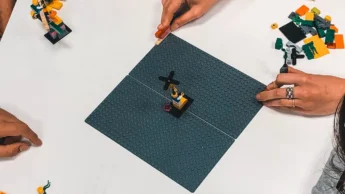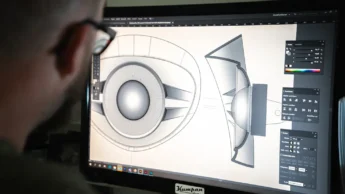When you want to develop your idea into a physical product, it is important to create a prototype to discover what your strengths and pitfalls are. There are many types of prototypes to choose from. Discover the different types of prototypes in this blog.
Prototypes come in many different shapes and sizes. You can elaborate your prototype on or with paper, elaborate it digitally or, for example, have it printed with a 3D printer. The different types of prototypes are classified into three different categories: low fidelity, medium fidelity and high fidelity.
Do you want to innovate and have your idea developed in collaboration with Beeliners? We would love to help you! Feel free to drop by for a cup of coffee and we will be happy to discuss the possibilities with you.
Low fidelity
Low fidelity prototypes are simple and rudimentary prototypes that are developed in a quick and inexpensive way, without paying much attention to details or finishing. They are usually made using paper, cardboard, fabric, clay or other readily available materials.
Low fidelity prototypes are used to explore, test and validate ideas early in the design process. They are easy to make and modify, allowing designers to experiment quickly and gather feedback from users, without investing in expensive and time-consuming manufacturing processes.
Low fidelity prototypes can take different forms, such as sketches, paper mock-ups, maquettes, storyboard, flowcharts or wireframes. They are often used early in the design process to visualise and test ideas, and to determine the basic structure and functionality of the product. They are also useful when communicating designs and ideas with team members and stakeholders.

Medium fidelity
Medium fidelity prototypes are prototypes that are more detailed and sophisticated than low fidelity prototypes, but less sophisticated and complex than high fidelity prototypes. They are in the middle of the prototyping spectrum and offer a good balance between functionality, usability and cost.
Medium fidelity prototypes can be developed using different tools and software, such as wireframing tools, interactive mock-up software or 3D printers. They offer more detail and realism than low fidelity prototypes, giving designers and stakeholders a better idea of how the final product will look and function.
Medium fidelity prototypes are useful for testing and refining the functionality and interactions of the design. They can be used to conduct user testing, gather feedback from users and validate the user experience. Moreover, medium fidelity prototypes are often cheaper and faster to produce than high fidelity prototypes, making them ideal for use in the middle of the design process, when many changes can still occur.
High fidelity
High fidelity prototypes are prototypes that are the most detailed, realistic and advanced of all prototypes. They include all visual, functional and technical aspects of the final product and are often produced using advanced software, tools and materials.
High fidelity prototypes are used to test and validate the design in a realistic environment and to simulate the user experience as accurately as possible. They can be used to measure product performance, perform user testing and gather feedback from customers and stakeholders.
High fidelity prototypes can take different forms, such as interactive web pages, software applications, physical models or 3D printed objects. They can also be used to test and validate the aesthetics, materials and workmanship of the product.
The disadvantage of high fidelity prototypes is that they are often expensive and time-consuming to develop and produce. Therefore, they are usually used in the final stage of the design process, when the design has already been refined and the designer wants to check whether the product functions properly and meets the needs of customers and stakeholders.
Working on your prototype together with Beeliners
Do you have a good idea for a product, service, process or technological innovation? And would you like to develop your idea into a prototype?
When working with Beeliners, we help you throughout the process. We think along with you and create a prototype together. We would love to help you! Feel free to drop by for a cup of coffee and we will be happy to discuss the possibilities with you.
Also interesting
-

Prototype ready, where to go from here?
The time has come! Your prototype is ready. You have developed all your ideas into a physical copy. Now it is time to take the next steps. How will you market your prototype? And what needs to happen first? Once your prototype is ready, your product is not yet ready… Read More
-

How do you make a prototype? 3 ways
To check whether your idea is really as good as you think it is, it is good to make a prototype of it. Making a prototype does not have to be so difficult or cost a lot of money or time. In this blog article, you will read about three… Read More
-

What is a prototype?
You have a great idea for renewal or innovation within your company. How do you make sure your idea becomes reality? A prototype will give you a good idea of how your idea will develop. But what is a prototype? When developing new ideas, a prototype is often used. In… Read More

